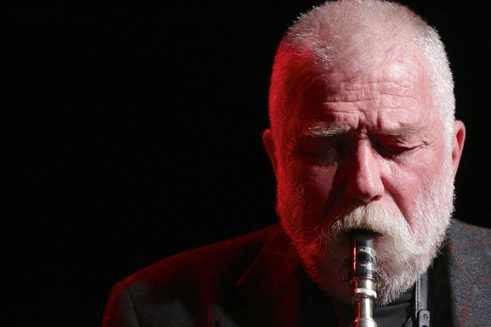Peter Brötzmann’s 75th birthday
Sounds are free

The meaning of freedom, Peter Brötzmann has said, he learned from painting. But his aesthetic stubbornness he developed all by himself, and thanks to it became one of the internationally best-known jazz musicians of Germany. On March 6th 2016 Brötzmann celebrates his 75th birthday.
Making a racket is part of the business. “There are two possibilities in goddamned art: either you meet the expectations or you sweat about it and try to find out, regardless of losses, what’s important to you”, said Peter Brötzmann in 2012 to the Bochum philosopher Christoph J. Bauer. “A brutal society naturally provokes brutal music”, the jazz musician, painter and graphic artist from Remscheid adds.
Provocation is a key concept: When in the early 1960s Brötzmann was becoming known, the Federal Republic of Germany was flourishing in the wake of the Economic Miracle. The Germans were somebody again, the trauma of the Nazi years was largely suppressed in everyday life, criticism of the new middle-class way of life and its belief in progress regarded as undesirable. Brötzmann, however, arrived at the Wuppertal School of Applied Arts together with, among other things, the freshly burgeoning ideas of the Fluxus movement, according to whose concept of performance any material at all could become an object of art.
This Fluxus experience in turn corresponded with the tendencies of Free Jazz, which around 1960 began to rebel against the limitations imposed by form, structure and musical regularities. Brötzmann was impressed by the radical nature of its ideas, and, as an artist, sobered up by the conservative nature of gallerists in the art world. He drew the consequences and reached for his saxophone.
Self-taught maverick
Brötzmann already had received clarinet lessons as a nine-year-old and afterwards continued to study the instrument and the saxophone autodidactically. Now music became his main interest, even though after graduation from art school in 1962 he worked as a graphic designer on the side. He met like-minded people and founded in the same year a trio with the bassist Peter Kowald and varying drummers, which attracted attention for itself on the strength of its creative vehemence.Enfant terrible for some, angry young man for others, Brötzmann was already playing at festivals throughout Europe by the mid-decade, found himself as a result together with international colleagues like Carla Bley, Aldo Romano and Michael Mantler, and in 1966 became part of the Globe Unity Orchestra, which experimented with free-style performance in large ensembles and is still active today. Recordings such as For Adolphe Sax (1967) in trio, no submissive homage to the inventor of the instrument but rather a cry, and Machine Gun (1968) in octet, a raw sound/noise performance, which became a fundamental work of Free Jazz, made Brötzmann known beyond the circle of experimental musicians and a figure in international jazz.
Since the music business looked upon the revolutionary impetus of these years with scepticism, Brötzmann, together with Peter Kowald, the pianist Alexander von Schlippenbach and the bassist Jost Gebers, founded the label Free Music Production (FMP), which held up the banner of the avant-garde until 2011 and became one of the most important forums for improvised music. Brötzmann himself shuttled during the 1970s between the holy seriousness of impulsive creativity and the Dadaist impetus of various performances – for instance, at the Berlin Total Music Meeting, where the Fluxus roots of earlier activities with Nam June Paik, but also Brötzmann’s own penchant for pictorial and visual art, came into play.
Revolution becomes institution
Abroad, because of his acoustic vehemence, Brötzmann was initially regarded as the vigorous jazz-German. Since the 1980s, however, this perception has changed. Brötzmann performed in Japan and the United States, and his influence on the musical worlds there grew. The bassist Bill Laswell invited him in 1986 to join his band Last Exit, and in his own ensembles such as the Chicago Tentet the next generation of jazz musicians such as Ken Vandermark and the Swedish saxophonist Mats Gustafsson grew up, oriented to the achievements of ultra-dynamic freedom. The Peter Brötzmann Trio 1974 in the TV-feature "Saxophone Stars" of the NDR, source: N3 / YoutubeAnd Brötzmann has played on and on, solo, in duos, in various ensembles, including with his son, the guitarist Caspar Brötzmann. He has recorded incessantly and can be heard on more than a hundred albums, has created album covers and posters (for instance, for the Total Music Meeting), painted in oils, screwed together objects, designed exhibitions of his own works, ranging from Chicago to Remscheid and Ljubljana. The sound-anarchist has become an old hand of German jazz, honored for his lifework by, for example, the New Yorker Vision Festival 2011 and with the German Jazz Prize 2011, awarded at the Berlin Jazz Festival.
Institution or revolution? Brötzmann’s demand for immediacy of spontaneous expression has not really changed. The times in which he finds himself, however, are now different. Free Jazz has long been a popular style of performance. Aesthetic provocation through eruptive force is part of everyday creative life, anger is applauded and a proven resource of improvised expression. So Brötzmann in 2016 is actually a romantic, an original genius creating out of himself, exemplary in the consistency of his opposition to jazz norms on his path to intensified expressiveness.